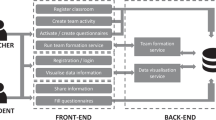Abstract
Teamwork is a critical competence in the higher education area, and it has become a critical task in educational and management environments. Unfortunately, looking for optimal or near optimal teams is a costly task for humans due to the exponential number of outcomes. In this paper, we present a web application that facilitates the task of automatic team generation of near optimal teams based on collective intelligence, coalition structure generation, and Bayesian learning. This tool has been used in real classroom scenario and the data collected from the experience has been used as input for synthetic simulations. The experiments show that the tool is able of converging towards the optimal solution (team formation) as long as students do not have great difficulties evaluating others.
Access this chapter
Tax calculation will be finalised at checkout
Purchases are for personal use only
Preview
Unable to display preview. Download preview PDF.
Similar content being viewed by others
References
Belbin, R.M.: Team roles at work. Routledge (2010)
Colomo-Palacios, R., Casado-Lumbreras, C., Soto-Acosta, P., Garcia-Peñalvo, F.J., Tovar, E.: Project managers in global software development teams: a study of the effects on productivity and performance. Software Quality Journal, 1–17 (2012)
Furnham, A., Steele, H., Pendleton, D.: A psychometric assessment of the belbin team-role self-perception inventory. Journal of Occupational and Organizational Psychology 66(3), 245–257 (1993)
Guzzo, R.A., Dickson, M.W.: Teams in organizations: Recent research on performance and effectiveness. Annual Review of Psychology 47(1), 307–338 (1996)
Guzzo, R.A., Shea, G.P.: Group performance and intergroup relations in organizations. In: Handbook of Industrial and Organizational Psychology, vol. 3, pp. 269–313 (1992)
Henry, S.M., Todd Stevens, K.: Using belbin’s leadership role to improve team effectiveness: an empirical investigation. Journal of Systems and Software 44(3), 241–250 (1999)
Higgs, M., Pewina, U., Ploch, J.: Influence of team composition and task complexity on team performance. Team Performance Management 11(7/8), 227–250 (2005)
Johnson, D.W., Johnson, R.T.: An educational psychology success story: Social interdependence theory and cooperative learning. Educational Researcher 38(5), 365–379 (2009)
Johnson, D.W., Johnson, R.T., Smith, K.: The state of cooperative learning in postsecondary and professional settings. Educational Psychology Review 19(1), 15–29 (2007)
Maffioli, F., Augusti, G.: Tuning engineering education into the european higher education orchestra. European Journal of Engineering Education 28(3), 251–273 (2003)
Ohta, N., Conitzer, V., Ichimura, R., Sakurai, Y., Iwasaki, A., Yokoo, M.: Coalition structure generation utilizing compact characteristic function representations. In: Gent, I.P. (ed.) CP 2009. LNCS, vol. 5732, pp. 623–638. Springer, Heidelberg (2009)
Pajares, S., Sanchez-Anguix, V., Torreño, A., Esparcia, S.: A novel teaching-learning strategy for teamwork based on agreement technologies. In: IJCA Proceedings on Design and Evaluation of Digital Content for Education (DEDCE), vol. (1), pp. 21–30 (2011)
Parker, G.M.: Team players and teamwork: New strategies for developing successful collaboration. John Wiley & Sons (2008)
Rahwan, T., Ramchurn, S.D., Jennings, N.R., Giovannucci, A.: An anytime algorithm for optimal coalition structure generation. Journal of Artificial Intelligence Research 34(2), 521 (2009)
Rajendran, M.: Analysis of team effectiveness in software development teams working on hardware and software environments using belbin self-perception inventory. Journal of Management Development 24(8), 738–753 (2005)
Russell, S.J., Norvig, P.: Artificial Intelligence: A Modern Approach. Prentice Hall (2010)
Russell, S.J., Norvig, P., Canny, J.F., Malik, J.M., Edwards, D.D.: Artificial intelligence: a modern approach, vol. 74. Prentice Hall, Englewood Cliffs (1995)
Sandholm, T., Larson, K., Andersson, M., Shehory, O., Tohmé, F.: Coalition structure generation with worst case guarantees. Artificial Intelligence 111(1), 209–238 (1999)
Senior, B., Swailes, S.: A comparison of the belbin self perception inventory and observer’s assessment sheet as measures of an individual’s team roles. International Journal of Selection and Assessment 6(1), 1–8 (1998)
Sundstrom, E., De Meuse, K.P., Futrell, D.: Work teams: Applications and effectiveness. American Psychologist 45(2), 120 (1990)
Swailes, S., McIntyre-Bhatty, T.: The belbin team role inventory: reinterpreting reliability estimates. Journal of Managerial Psychology 17(6), 529–536 (2002)
Wheelan, S.A.: Creating effective teams: A guide for members and leaders. Sage (2010)
Author information
Authors and Affiliations
Corresponding author
Editor information
Editors and Affiliations
Rights and permissions
Copyright information
© 2014 Springer International Publishing Switzerland
About this paper
Cite this paper
del Val, E., Alberola, J.M., Sanchez-Anguix, V., Palomares, A., Teruel, M.D. (2014). A Team Formation Tool for Educational Environments. In: Bajo Perez, J., et al. Trends in Practical Applications of Heterogeneous Multi-Agent Systems. The PAAMS Collection. Advances in Intelligent Systems and Computing, vol 293. Springer, Cham. https://doi.org/10.1007/978-3-319-07476-4_21
Download citation
DOI: https://doi.org/10.1007/978-3-319-07476-4_21
Publisher Name: Springer, Cham
Print ISBN: 978-3-319-07475-7
Online ISBN: 978-3-319-07476-4
eBook Packages: EngineeringEngineering (R0)




